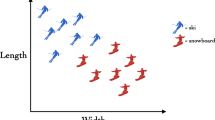Abstract
There is an intensive discussion nowadays about the meaning of effective computability, with implications to the status and provability of the Church–Turing Thesis (CTT). I begin by reviewing what has become the dominant account of the way Turing and Church viewed, in 1936, effective computability. According to this account, to which I refer as the Gandy–Sieg account, Turing and Church aimed to characterize the functions that can be computed by a human computer. In addition, Turing provided a highly convincing argument for CTT by analyzing the processes carried out by a human computer. I then contend that if the Gandy–Sieg account is correct, then the notion of effective computability has changed after 1936. Today computer scientists view effective computability in terms of finite machine computation. My contention is supported by the current formulations of CTT, which always refer to machine computation, and by the current argumentation for CTT, which is different from the main arguments advanced by Turing and Church. I finally turn to discuss Robin Gandy's characterization of machine computation. I suggest that there is an ambiguity regarding the types of machines Gandy was postulating. I offer three interpretations, which differ in their scope and limitations, and conclude that none provides the basis for claiming that Gandy characterized finite machine computation.
Similar content being viewed by others
References
Astrachan, O.L. (2000), A Computer Science Tapestry: Exploring Programming and Computer Science with C++, US: McGraw-Hill.
Boolos, G.S. and Jeffrey R.C. (1989), Computability and Logic, Cambridge: Cambridge University Press.
Church, A. (1936a), 'An Unsolvable Problem of Elementary Number Theory' American Journal of Mathernatics 58, pp. 345–363. Reprinted in Davis (1965), pp. 88–107.
Church, A. (1936b), 'A Note on the Entscheidungsproblem', Journal of Symbolic Logic 1, pp. 40–41. Reprinted in Davis (1965), pp. 108–115.
Church, A. (1937a), 'Review of Turing (1936)', Journal of Symbolic Logic 2, pp. 42–43.
Church, A. (1937b), 'Review of Post (1936)', Journal of Symbolic Logic 2, p. 43.
Cleland, C. (1993), 'Is the Church–Turing Thesis True?', Minds and Machines 3, pp. 283–312.
Cleland, C. (forthcoming), 'Effective Procedures and Causal Processes', Minds and Machines.
Copeland, B.J. (1996), The Church–Turing Thesis', in J. Perry and E. Zalta, eds., The Stanford Encyclopedia of Philosophy. [http://plato.stanford.edu]
Davis, M. (ed.), (1965) The Undecidable: Basic Papers on Undecidable Propositions, Unsolvable Problems and Computable Functions, NewYork: Raven.
Deutsch, D. (1985), 'Quantum Theory: The Church–Turing Principle and the Universal Quantum Computer',' Proceedings of the Royal Society of London A 400, pp. 97–117.
Gandy, R.O. (1980), 'Church's Thesis and Principles of Mechanisms', in J. Barwise, J.J. Keisler and K. Kunen, eds., The Kleene Symposium, Amsterdam: North-Holland, pp. 123–145.
Gandy, R.O. (1988), 'The Confluence of Ideas in 1936', in Herken, pp. 55–111.
Gödel, K. (1931), 'On Formally Undecidable Propositions of Principia Mathematica and Related Systems I', Monatshefte für Mathematik und Physik 38, pp. 173–198. Translated and Reprinted in Davis (1965) pp. 5–38.
Gödel, K. (1946), 'Remarks Before the Princeton Bicentennial Conference on Problems in Mathematics'. Reprinted in Davis (1965), pp. 84–88.
Harel, D. (1992), Algorithms: The Spirit of Computing (second edition), Reading, MA: Addison-Wesley.
Herken, R.(ed.) (1988). The Universal Turing Machine A Half-Century Survey, Oxford: Oxford University Press.
Hilbert, D. and Ackermann, W. (1928), Grundzuge der Theoretischen Logic, Berlin: Springer-Verlag.
Hilbert, D. and Bernays, P. (1939), Grundlagen der Mathematik II, Berlin: Springer-Verlag.
Hogarth, M.L. (1994), 'Non-Turing Computers and Non-Turing Computability', Proceedings of the Philosophy of Science Association (PSA) 1, pp. 126–138.
Hopcroft, J.C. and Ullman, J.D. (1979), Introduction to Automata Theory, Languages and Computation, Reading, MA: Addison-Wesley.
Kleene, S.C. (1936), 'General Recursive Functions of Natural Numbers', Mathematische Annalen 112, pp. 727–742. Reprinted in Davis (1965), pp. 236–253.
Kleene, S.C. (1988), 'Turing's Analysis of Computability, and Major Applications of It',' in Herken, pp. 17–54.
Lewis, H.R. and Papadimitriou, C.H. (1981), Elements of the Theory of Computation, Eaglewood Cliffs, NJ: Prentice-Hall.
Mancosu, P. (1999), 'Between Russell and Hilbert: Behmann on the Foundations of Mathematics'.Bulletin of Symbolic Logic 5, pp. 303–330.
Nagin, P. and Impagliazzo J. (1995), Computer Science: A Breadth-First Approach with Pascal, New York: John Wiley & Sons.
Pitowsky, I. (1990), 'The Physical Church Thesis and Physical Computational Complexity', Iyyun 39, pp. 81–99.
Post, E.L. (1936), 'Finitary Combinatory Processes – Formulation I', Journal of Symbolic Logic 1, pp. 103–105. Reprinted in Davis, (1965), pp. 288–291.
Shagrir, O. (1992) 'A Neural Net with Self-Inhibiting Units for the N-Queens Problem', International Journal of Neural Systems 3, pp. 249–252.
Shagrir, O. (1997), 'Two Dogmas of Computationalism' Minds and Machines 7, pp. 321–344.
Shagrir, O. and Pitowsky, I. (forthcoming), 'Physical Hypercomputation and the Church–Turing Thesis', Minds and Machines.
Shepherdson, J.C. (1988), 'Mechanisms for Computing Over Arbitratry Structures', in Herken, pp. 537–555.
Sieg, W. (1994), 'Mechanical Procedures and Mathematical Experience', in A. George, ed., Mathematics and Mind, Oxford: Oxford University Press, pp. 71–117.
Sieg, W. (1997), 'Step by Recursive Step: Church's Analysis of Effective Calculability', Bulletin of Symbolic Logic 2, pp. 154–180.
Sieg, W. (2001), 'Calculation by Man and Machine: Conceptual Analysis', in W. Sieg, R. Sommer and C. Talcott, eds., Reflections on the Foundations of Mathematics (Essays in Honor of Solomon Feferman), Volume 15 of Lectures Notes in Logic, Association of Symbolic Logic, pp. 387–406.
Sieg,W. (forthcoming), 'Calculation byMan andMachine: Mathematical Presentation', Proceedings of the International Congress of Logic, Methodology and Philosophy of Science (Cracow, 1999), Kluwer, pp. 246–260.
Sieg,W. and Byrnes, J. (1999), 'An Abstract Model for Parallel Computations: Gandy's Thesis', The Monist 82, pp. 150–164.
Siegelmann, H.T. (1995), 'Computation Beyond Turing Limit', Science 268, pp. 545–548.
Turing, A.M. (1936), 'On Computable Numbers, with an Application to the Entscheidungsproblem', Proceedings of the London Mathematical Society (2) 42, pp. 230-265. A correction in 43 (1937), pp. 544–546. Reprinted in Davis (1965), pp. 115–154.
Wolfarm, S. (1985), 'Undecidability and Intractability in Theoretical Physics', Physical Review Letters 54, pp. 735–738.
Author information
Authors and Affiliations
Rights and permissions
About this article
Cite this article
Shagrir, O. Effective Computation by Humans and Machines. Minds and Machines 12, 221–240 (2002). https://doi.org/10.1023/A:1015694932257
Issue Date:
DOI: https://doi.org/10.1023/A:1015694932257




